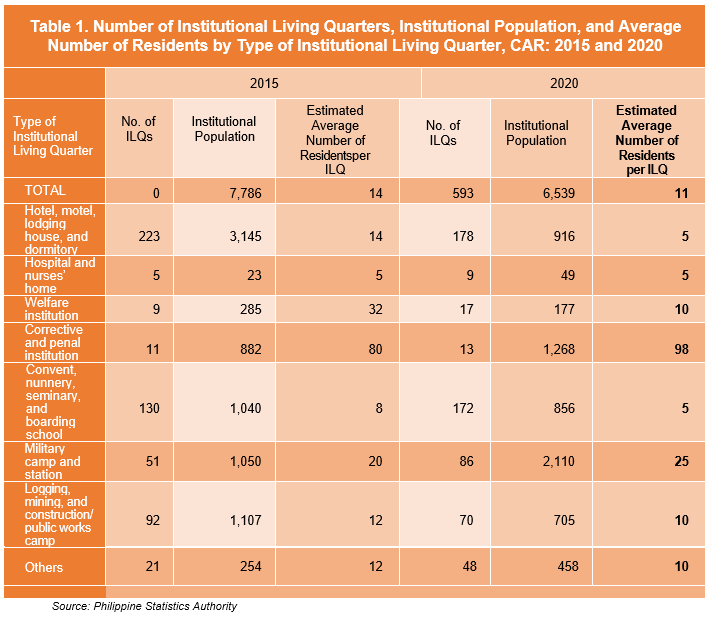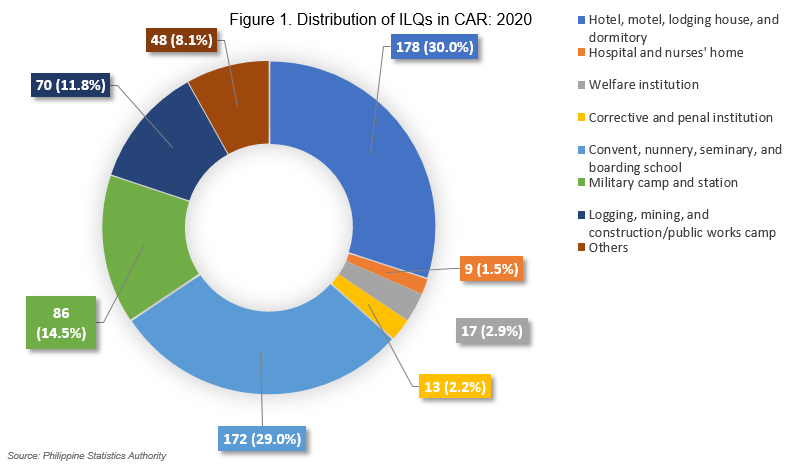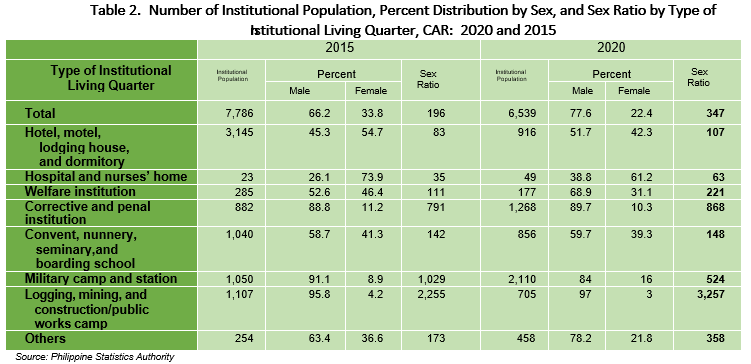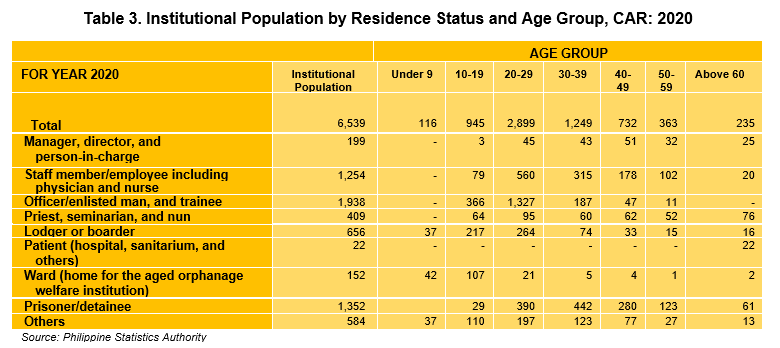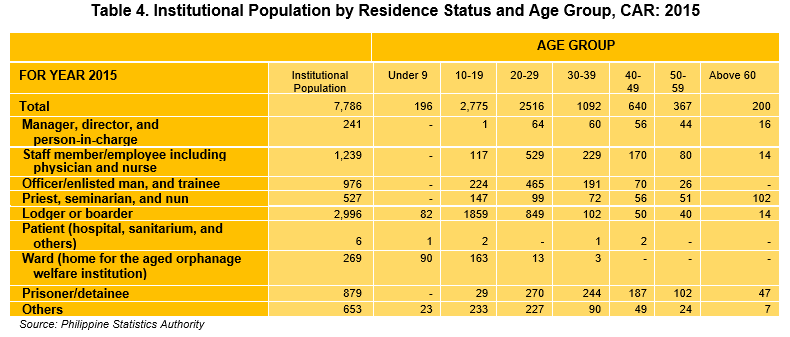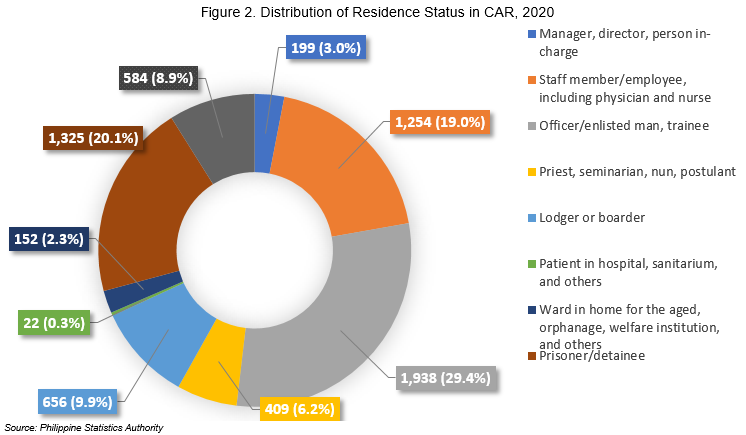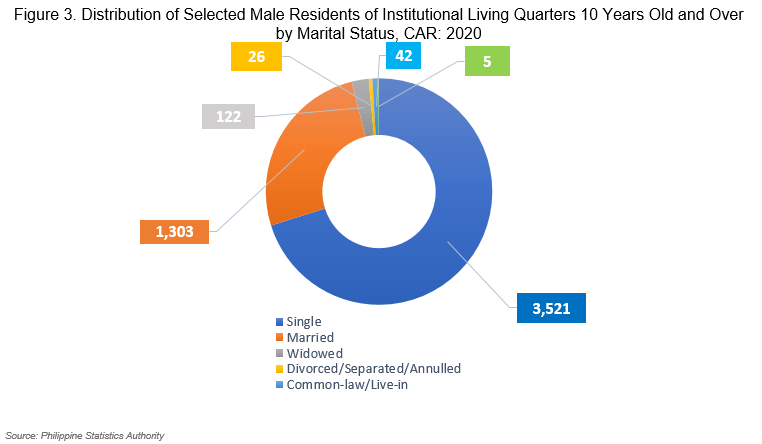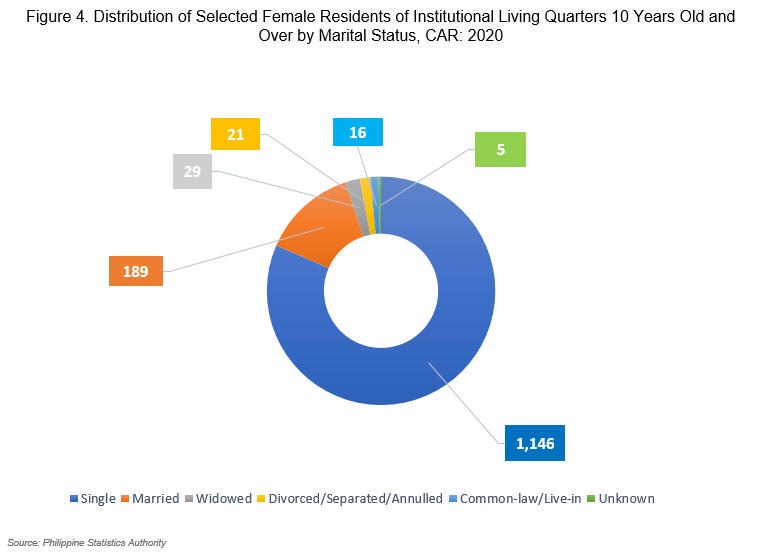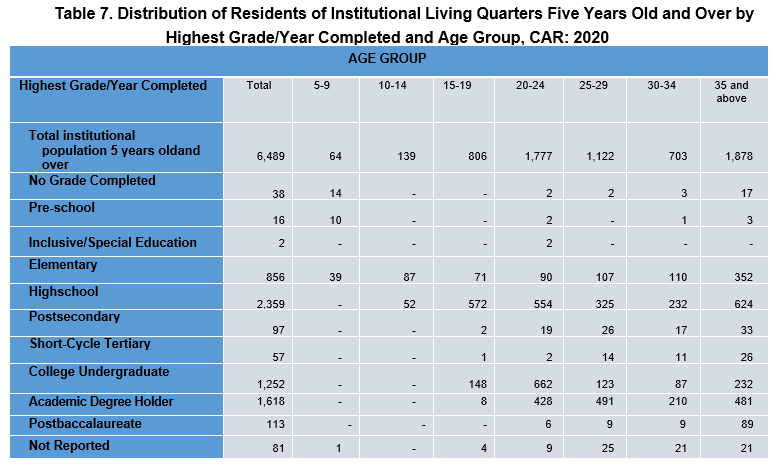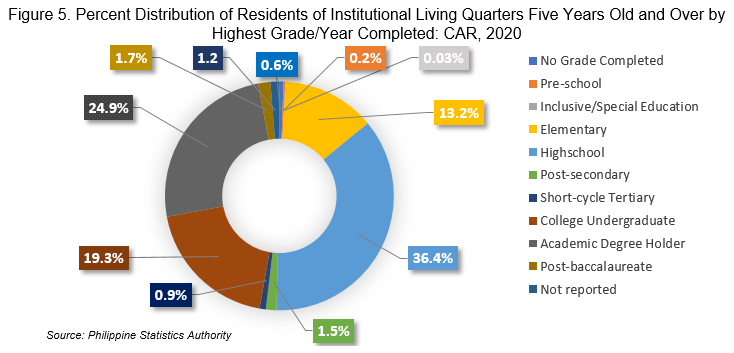Institutional population decreases by more than 1,247
- Based on the 2020 Census of Population and Housing, the institutional population of Cordillera Administrative Region reached 6,539 residents equivalent to 0.006 percent of the country’s total population of 109,035,343 residents. This quantity was 1,247 residents or 16.02 percent lower than 7,786 residents recorded in 2015 census (Table 1).
- The number of institutional living quarters (ILQs) increased from 542 ILQs in 2015 to 593 in 2020, which means an additional 51 ILQS, equivalent to 9.41 percent (Table 1).
- The total number of ILQs and institutional population translated to an average of 11 residents or institutional population per ILQ. This is lower than the average of 14 residents per ILQ in 2015 (Table 1).
Three-tenths of the institutional population in 2020 reside in military and camp station
- In an institutional population of 6,359, there were 2,110 residents (32.3%) who resided in military camp and stations. This was followed by residents in corrective and penal institution with 1,268 residents (19.9%) and hotel, motel, lodging house, and dormitory with 916 residents (14.4%). The least figure was obtained by hospital and nurses’ home with 49 residents (0.7%). It was also the least number of residents in 2015 (Table 1).
- Back in 2015 with a total of 7,768 institutional population, residents residing in hotels, motels, lodging houses, and dormitories was the most numerous institution with 3,145 residents (40.4%). The second most numerous institutions in 2015 was logging, mining, and construction/public works camp 1,107 residents (14.4%), and third with 1,040 residents (13.4%), the military camp and stations was ranked (Table 1).
Hotels, motels, lodging houses, and dormitories decrease by 45
- In 2020, hotel, motel, lodging house, and dormitory decreased by 45 from 223 in 2015, down to 178 institutions or 30 percent of total institutions (Table 1 and Figure 1).
- On the other hand, an increase in the number of convents, nunnery, seminary, and boarding school was recorded. From 130 in 2015, it increased to 172, equivalent to 29 percent of the total institutions (Table 1 and Figure 1).
Four in every five ILQ residents are male
- 77.6 residents residing in ILQs were males while 22.4 percent were females. These figures resulted to a sex ratio of 347 males per 100 females (Table 2).
- Males outnumbered females in all types of ILQ, except in hospital and nurses’ home, where females accounted for 61.2 percent while males comprised 38.8 percent, resulting to a sex ratio of 63 males for every 100 females. The highest sex ratio recorded was in logging, mining, and construction/ public works camp, wherein there were 3,257 males for every 100 females (Table 2).
Most of the residents in ILQs belong to age group 20-29
- Out of 6,539 institutional population, 2,899 residents (44.3%) belong to ages ranging from 20-29 years old while people aged 30-39 years with of 1,249 residents (19.1%). Followed by 10-19 years, 40-49 years, 50-59 years, and above 60 years with 945 residents (14.5%), 732 residents (11.2%), 363 residents (5.6%) and 235 residents (3.6%), respectively. The least age group were people under 9 years with 116 residents (1.8%) only (Table 3).
Lodger or boarder posts largest decrease
- The largest decrease posted was lodger or boarder. In 2015, there were 2,996 lodgers or boarders. It decreased by 2,340, leading to only 656 lodgers in 2020. A large decrease in number was also recorded in priest, seminarian & nun, ward (home for the aged orphanage welfare institution), and manager, director & person-in-charge. They decreased by 118 residents, 117 residents, and 42 residents (Table 3 and Table 4).
Officer/enlisted man, and trainee is the leading residence status of 2020
- Officer/enlisted man or trainee was the leading residence status with 1,938 residents. This was followed by prisoner/detainee with 1,352 residents. Staff member/employee including physician and nurse was third with 1,254 residents. The fourth to eighth were lodger or boarder (656 residents), others (584), priest, seminarian, nun, or postulant manager (404 residents), director, or person in-charge (199 residents), and ward in home for the aged, orphanage, welfare institution, and others (152 residents).
- With 22 residents, the least recorded residence status was patient in hospital, sanitarium, and others (Table 3 and Figure 2).
- Officer/enlisted man, and trainee also recorded the highest increase. It increased by 962 from 976 in 2015 to 1,938. A large increase in detainee/prisoner was also posted, from 879 in 2015 to a total of 1,352 residents (Table 3 and Table 4).
Majority of institutional population are single
- Approximately three-fourths (72.7%) of the 6,423 ILQ residents aged 10 years old and over was single with a record of 4,667 residents. The rest of the institutional population 10 years old and above was categorized as follows: married with 1,492 residents (23.2%), widowed had 151 residents (2.4%), common-law/live-in posted 58 residents (0.9%), divorced/separated with 47 residents (0.7%), and (0.1%) are eight residents unknown (Table 5 and Figure 3).
Males dominates all marital status of ILQs 10 Years Old and Over
- Males outnumbered females in all marital status with the 78.1 percent (5,019 residents) compared to only female’s 21.9 percent (1,404 residents) of total institutional population 10 years old and over (Figure 3 and 4).
- In 5,019 aged over 10 years old males, 3,521 were single, 1,303 had tied the knots, 151 lost their partners, 26 were separated, 42 were common-law/live-in, and 5 unknowns (Figure 3).
- A total of 1,404 females aged over 10 years old recorded in 2020. This comprise of 1,146 single, 189 married, 29 widowed, 21 were divorced/separated/annulled, 16 were common-law/live-in, and only 3 unknowns (Figure 4).
Most ILQ residents achieve high school level at most
- The 36.4 percent (2,359 residents) of the institutional population five years old and over had reached or completed high school level at most. Meanwhile, 24.9 percent (1,618 residents) were academic degree holders. College undergraduates and elementary level comprised 19.3 percent (1,252 residents) and 13.2 percent (856 residents), respectively (Tables 7).
- The age group 35 and above produced the greatest number of ILQ residents had completed high school, elementary, and post-baccalaureate with 624, 352, and 89 residents, respectively. Meanwhile, age group 25-29 recorded the highest number of academic degree holders with 491 ILQ residents aged five years and over (Table 7 and Figure 5).
Technical Notes
Highest Grade/Year Completed refers to the highest grade or year attained in school, college, or university. This may be any one of the specific grades or years in elementary, high school, post-secondary school, college, and post baccalaureate levels of schooling. It also includes preschool education.
Institutional Living Quarter (ILQ) is the place of abode of an institutional population is not called a housing unit; it is referred to as an institutional living quarter (ILQ). An ILQ is a structurally separate and independent place of abode intended for habitation by large groups of individuals (10 or more).
Institutional Population refers to the population enumerated during a census living in large institutions, such as national prisons and penal colonies, provincial and large city jails, tuberculosis sanitaria, mental hospitals, leprosaria, military, mining, and logging camps, etc. The cut-off is more than 6-months duration.
Marital Status is a person's state of being single, married, separated, divorced, or widowed.
Residence Status refers to the residence position or status of a person in the ILQ.


